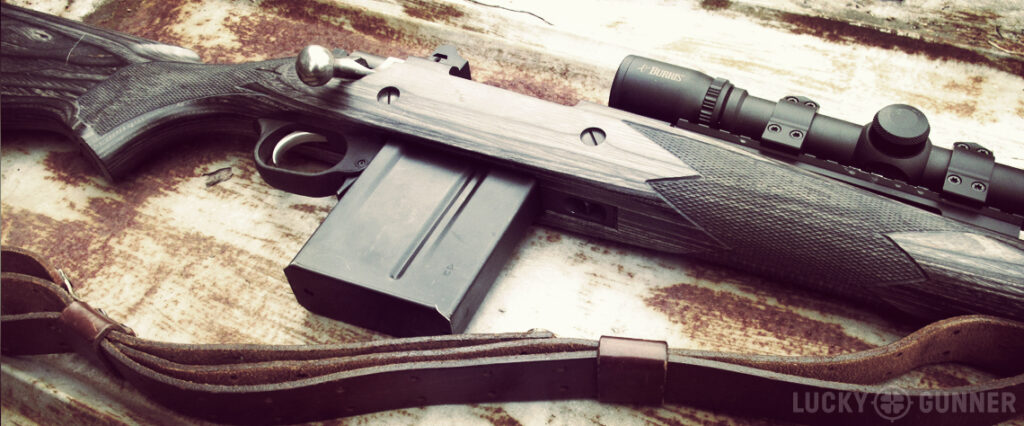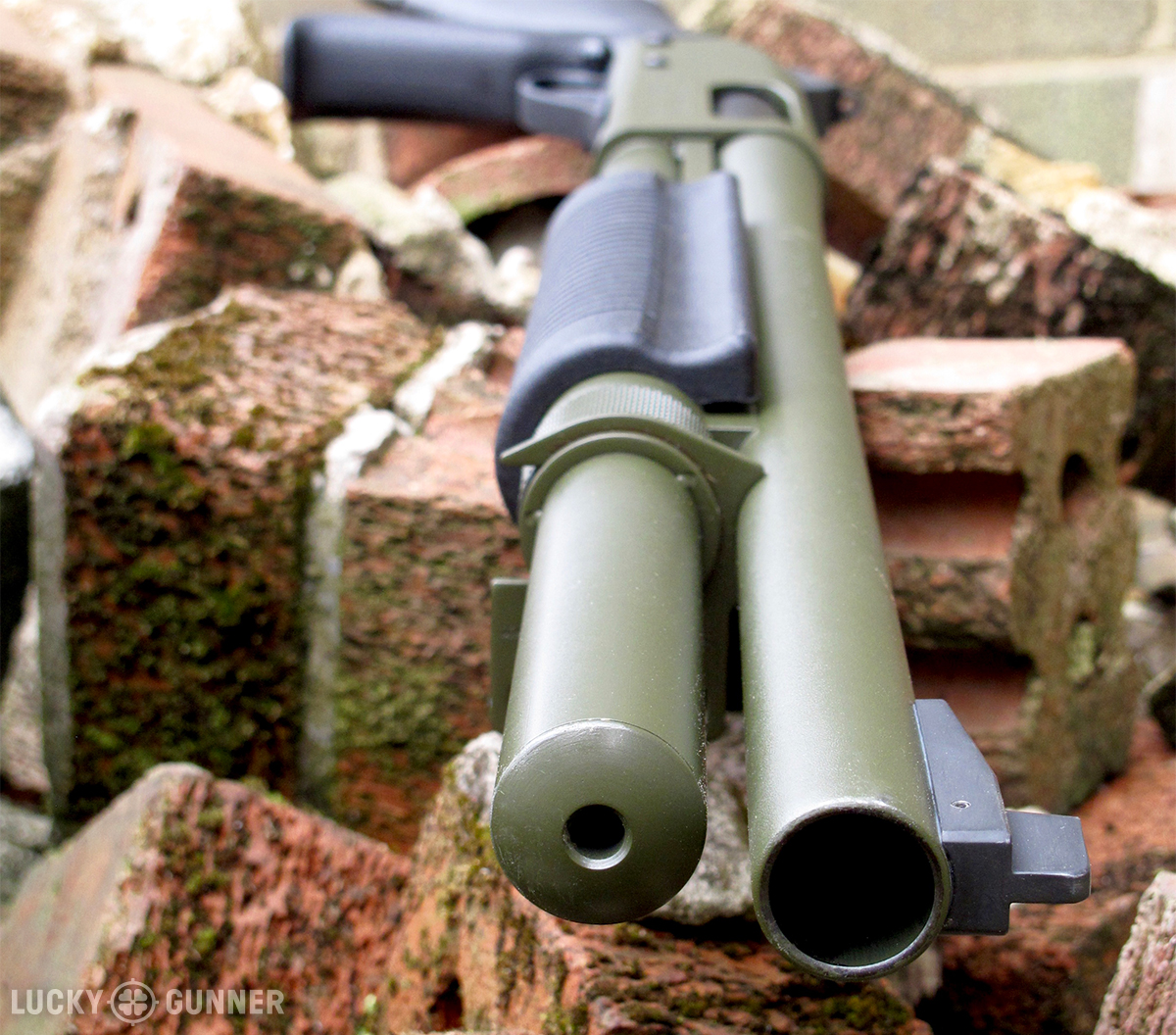Last week I wrote about the handguns that I own as part of my experiment in what some might call self denial, and what I call a minimalist, utilitarian or budget-minded approach, as the mood may find me. Today, I am going to cover the the long arms I have chosen to round out my purely functional battery. Long guns represent an entirely separate class of firearms, and no respectable setup would be complete without at least a shotgun and a rifle.
Shotgun
Since The Lounge is in the middle of a series on defensive shotguns, I will lead this off with mine: the Wilson Combat/Scattergun Technologies Border Patrol. The Border Patrol is a Remington 870 with a heavy-duty set of custom features. Wilson Combat will retrofit your 870 or sell you a complete package; I opted for the latter and mine is an Express model. The action has been slicked up nicely, and the whole gun has been coated in a durable Armor-Tuff finish, OD-green being my preferred color. The magazine tube of the Border Patrol holds six rounds that are pushed by a non-binding, extra-strength spring and a high-visibility follower.
Though this particular model comes standard with a Mesa Tactical sidesaddle, I opted to remove it and increase on-board capacity with a SpeedFeed stock instead. The stock, which holds four extra rounds, has a couple ancillary benefits. First, the weight of the extra ammo at the rear of the gun helps to balance the extended magazine tube. Next, the pistol grip profile works really well with the Vang Comp Systems Big Dome Safety, which I prefer over Wilson Combat’s enhanced safety button. When you assume a firing grip and move your finger onto the trigger, the second joint of your index finger automatically depresses the safety and puts the weapon into firing condition. A strike against the sidesaddle: it prevents the gun from sitting flat against the body when using a two-point sling.
My favorite feature of the Border Patrol is the excellent set of ghost ring sights that is included standard. The extremely robust front blade features a tritium insert for nighttime and low-light use. The yawning rear aperture is adjustable for both windage and elevation and sacrifices little, if anything, in close-range speed. Good sights, like these ghost rings, can turn a shotgun into a 100-yard gun with practice. Even a moderately skilled shooter can consistently place slugs on a human-sized silhouette at that distance. They can also increase the effective range with modern buckshot and render dubious the “scatter” in scattergun. My Border Patrol 870 will keep all nine pellets of a Federal FliteControl round well within an 8” circle out to around 35 yards, and keep them all on a silhouette at fifty. This is well beyond most bedroom, or even front-yard, distances, but I’d rather have it and not need than the other way around. Best of all, the ghost ring arrangement is very similar to that mounted on my rifle of choice, which means familiarity.
The pump shotgun – any pump shotgun – is one of those arms that fit my overarching concept: versatile, utilitarian, and about as flashy as a mud puddle. But again, it does all sorts of things decently, and a few superbly. The shotgun is about as close to “ultimate” as one can get when considering interventions for close-range, interpersonal conflict. With the average 12-gauge one-ounce rifled slug producing somewhere in the neighborhood of 2,500 ft-lbs of muzzle energy, the shotgun is also a formidable defensive tool against heavy hided animals. Loaded properly, a shotgun is also a capable, respected tool for taking game ranging from squirrels to bears, and just about everything in between.
Rifle
A shotgun is a lot of things, but there is one thing it isn’t: a rifle. When a rifle is called for there is no substitute, and no serious collection would be complete without one. A rifle offers a much higher degree of precision, and it carries energy out to much great distances. Though I am not a hunter, I still feel a strong need to keep and maintain a rifle for no other reason than “when a man picks up a rifle [he changes] instantly from a subject to a citizen.” And every Marine is a rifleman, after all.
Before I get into my choice, you should know that I am a chronic sufferer of AR-Fatigue. Though I have trained with this platform, used it on the job, and owned a number of ARs for personal use, I admit to being, quite frankly, no longer passionate about them. They are a fun gun to shoot and, despite numerous opinions on The Internets, it’s a plenty potent fighting arm. Still, I decided to go with something completely, radically different. I don’t routinely get in protracted gunfights, nor do I want to, so I opted for something that meets the spirit of compromise and versatility that this experiment is truly about. I chose another general purpose gun, the utility infielder of shoulder-fired weapons, “The one rifle to have if you could only have one,” the Ruger Gunsite Scout.
The Gunsite Scout Rifle is probably one of the most written-about and thoroughly photographed firearms of recent years, so I won’t bore you with rote statistics. Instead, I’ll just focus on mine. In the interest of being as economical as possible, I bought my GSR on the second-hand market. It was barely used but available at a deep discount. Because this rifle isn’t meant to be a specialist, I haven’t tried to turn it into one. The only modifications I’ve installed or planned are congruent with the original scout concept: the addition of a Burris Scout 2.75x scope in a set of quick-detach rings. In the very near future, I also plan to add the other requisite component of this package: a Ching Sling or Safari Sling. Other than that, the only additional costs are the relatively expensive spare magazines and plenty of practice ammunition. Zeroing this gun with 150-grain premium hunting ammunition allows me to practice relatively cheaply with military surplus while retaining the ability to switch to the “good stuff” should I need to.
I love the concept of the scout rifle – a light, handy carbine that is hard-hitting, can be carried all day, and fills both hunting or self defense roles adequately. It isn’t a sniper rifle or a super long-range hunter, but I’m perfectly confident in it out to 300 yards, the farthest I’ve been able to shoot it to this point. It obviously isn’t an ideal defensive tool, but against the threats I’m likely to face as a civilian, it’s certainly nothing to disregard, either. I recently did an all-day range session with the Scout, starting at the 10-yard line and working my way back to 300. I used both the optic and iron sights, in the the traditional offhand, kneeling, and prone positions. I walked off the range that day with complete confidence in the Scout and the feeling that any needs I have that can be filled with a rifle are pretty well covered.
The Missing Link?
Between the two of these guns I feel that I can more than adequately defend myself against man and beast, hunt anything I am ever likely to hunt, and satisfactorily entertain myself at the range. And if the “zombie apocalypse” or some other incredibly unlikely event occurs, I certainly won’t feel unarmed or terribly disadvantaged. However, the one thing I sometimes think I may be missing is a very light, very fast carbine, which gets me thinking that the ideal carbine for me might be a lever-action .357 Magnum.
There are several things I like about this idea. First, it wouldn’t require me to stock a new caliber of ammunition. It would compliment my revolvers nicely and shoot everything on the 38 Special/.357 Magnum spectrum. It would also boost the performance of these rounds, especially the heavier .357s, and do so in a more practically accurate form factor than a revolver. This would make a great casual plinking and light hunting gun as well as an excellent home defense carbine, and it’s just offbeat enough to be interesting. The models up for consideration are the Marlin 1894C and the Henry Big Boy Steel Carbine. I like the looks and the factory 16.5” barrel of the Henry much better, but I’m not sure I could live without the Marlin’s ability to be “tactically” reloaded from the side of the receiver… Decisions.
On the other hand, the cost of a new gun would pay for a lot of ammunition or come close to paying tuition for a five-day training course on one of the platforms I already own. Even though I spend a good deal of time shooting these guns, there is no substitute for formal training. Right now I’m tagging my desire for a pistol-caliber carbine with “nice-to-have” and “maybe-one-day” and declaring that there really is no missing link in my long-gun case. At least for me, at least in this moment. I’d rather spend my money where it will give me the most return on investment.
Final Thoughts
Roughly a year into this experiment, I have given you a peek into my own gun lifestyle: I own a grand total of four firearms. Two revolvers, a shotgun, and a high-powered rifle. I am considering adding an additional handgun and possibly a pistol-caliber carbine to my collection in the future. I stock four calibers of ammunition: .38 Special, .357 Magnum, .308 Winchester, and 12 gauge. It has been pointed out by many of my shooting friends that I don’t have an AR-15 or a .22, or (insert pet firearm[s] of choice here). I admit that having more specialized guns is fun, and there will probably come a day when I decide to buy a few more. But for now, I am really satisfied with the spirit of “using what I have and making it work,” learning some new action types, and saving a little money.
I wrote in the first article of this series that it’s not my intent to discourage you from owning as many guns as you want. Rather I wanted to share the extremely gratifying feeling I have gotten from this experience. I am incredibly familiar with my guns. I can afford to “support” them with accessories and ammunition, and to train hard on them.


